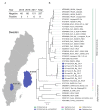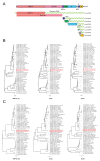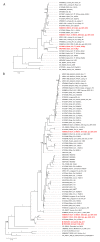Discovery of a Novel Coronavirus in Swedish Bank Voles (Myodes glareolus)
- PMID: 35746677
- PMCID: PMC9230040
- DOI: 10.3390/v14061205
Discovery of a Novel Coronavirus in Swedish Bank Voles (Myodes glareolus)
Abstract
The unprecedented pandemic COVID-19, caused by severe acute respiratory syndrome coronavirus 2 (SARS-CoV-2), with bats as original reservoirs, has once again highlighted the importance of exploring the interface of wildlife diseases and human health. In this study, we identified a novel Betacoronavirus from bank voles (Myodes glareolus) in Grimsö, Sweden, and this virus is designated as Grimso virus. Repeated detection over three years and an overall prevalence of 3.4% suggest that the virus commonly occurs in bank voles. Furthermore, phylogenetic analyses indicate that the Grimso virus belongs to a highly divergent Embecovirus lineage predominantly associated with bank voles. Given that bank voles are one of the most common rodent species in Sweden and Europe, our findings indicate that Grimso virus might be circulating widely in bank voles and further point out the importance of sentinel surveillance of coronaviruses in wild small mammalian animals, especially in wild rodents.
Keywords: RNA-sequencing; bank voles; coronavirus; prevalence.
Conflict of interest statement
The authors declare no conflict of interest. The funders had no role in the design of the study; in the collection, analyses, or interpretation of data; in the writing of the manuscript, or in the decision to publish the results.
Figures



Similar articles
-
Assessment of genetic diversity, tissue tropism, and antigenic properties of Grimsö betacoronavirus in Swedish bank voles (Clethrionomys glareolus).One Health. 2024 Oct 9;19:100911. doi: 10.1016/j.onehlt.2024.100911. eCollection 2024 Dec. One Health. 2024. PMID: 40206840 Free PMC article.
-
Lack of detection of SARS-CoV-2 in British wildlife 2020-21 and first description of a stoat (Mustela erminea) Minacovirus.J Gen Virol. 2023 Dec;104(12):001917. doi: 10.1099/jgv.0.001917. J Gen Virol. 2023. PMID: 38059490 Free PMC article.
-
Islet autoantibodies present in association with Ljungan virus infection in bank voles (Myodes glareolus) in northern Sweden.J Med Virol. 2017 Jan;89(1):24-31. doi: 10.1002/jmv.24597. Epub 2016 Jun 21. J Med Virol. 2017. PMID: 27283793
-
Population Dynamics of Bank Voles Predicts Human Puumala Hantavirus Risk.Ecohealth. 2019 Sep;16(3):545-557. doi: 10.1007/s10393-019-01424-4. Epub 2019 Jul 15. Ecohealth. 2019. PMID: 31309365 Free PMC article.
-
Experimental infections of wild bank voles (Myodes glareolus) from nephropatia epidemica endemic and non-endemic regions revealed slight differences in Puumala virological course and immunological responses.Virus Res. 2017 May 2;235:67-72. doi: 10.1016/j.virusres.2017.04.004. Epub 2017 Apr 8. Virus Res. 2017. PMID: 28396283
Cited by
-
Nephropathia Epidemica Caused by Puumala Virus in Bank Voles, Scania, Southern Sweden.Emerg Infect Dis. 2024 Apr;30(4):732-737. doi: 10.3201/eid3004.231414. Emerg Infect Dis. 2024. PMID: 38526134 Free PMC article.
-
No Evidence for the Presence of SARS-CoV-2 in Bank Voles and Other Rodents in Germany, 2020-2022.Pathogens. 2022 Sep 28;11(10):1112. doi: 10.3390/pathogens11101112. Pathogens. 2022. PMID: 36297169 Free PMC article.
-
Surveillance, Prevention, Evolution and Control of Emerging Viruses: A 2022 Editorial Update.Viruses. 2023 Oct 17;15(10):2098. doi: 10.3390/v15102098. Viruses. 2023. PMID: 37896875 Free PMC article.
-
Positive selection, genetic recombination, and intra-host evolution in novel equine coronavirus genomes and other members of the Embecovirus subgenus.Microbiol Spectr. 2024 Nov 5;12(11):e0086724. doi: 10.1128/spectrum.00867-24. Epub 2024 Oct 7. Microbiol Spectr. 2024. PMID: 39373506 Free PMC article.
-
Assessment of genetic diversity, tissue tropism, and antigenic properties of Grimsö betacoronavirus in Swedish bank voles (Clethrionomys glareolus).One Health. 2024 Oct 9;19:100911. doi: 10.1016/j.onehlt.2024.100911. eCollection 2024 Dec. One Health. 2024. PMID: 40206840 Free PMC article.
References
-
- Lau S.K., Woo P.C., Li K.S., Tsang A.K., Fan R.Y., Luk H.K., Cai J.P., Chan K.H., Zheng B.J., Wang M., et al. Discovery of a novel coronavirus, China Rattus coronavirus HKU24, from Norway rats supports the murine origin of Betacoronavirus 1 and has implications for the ancestor of Betacoronavirus lineage A. J. Virol. 2015;89:3076–3092. doi: 10.1128/JVI.02420-14. - DOI - PMC - PubMed
-
- Ling J., Sironen T., Voutilainen L., Hepojoki S., Niemimaa J., Isoviita V.M., Vaheri A., Henttonen H., Vapalahti O. Hantaviruses in Finnish soricomorphs: Evidence for two distinct hantaviruses carried by Sorex araneus suggesting ancient host-switch. Infect. Genet. Evol. 2014;27:51–61. doi: 10.1016/j.meegid.2014.06.023. - DOI - PubMed
Publication types
MeSH terms
LinkOut - more resources
Full Text Sources
Medical
Miscellaneous

